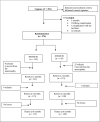Effect on infant illness of maternal supplementation with 400 000 IU vs 200 000 IU of vitamin A
- PMID: 22412025
- PMCID: PMC3313630
- DOI: 10.1542/peds.2011-0119
Effect on infant illness of maternal supplementation with 400 000 IU vs 200 000 IU of vitamin A
Abstract
Background and objective: Postpartum vitamin A supplementation is a strategy used to combat vitamin A deficiency and seems to reduce maternal/infant morbidity and mortality. However, studies have shown that a dose of 200 000 IU (World Health Organization [WHO] protocol) does not seem to provide adequate retinol levels in maternal breast milk, infant serum, and infant tissue. The objective of this study was to compare the effect of postpartum maternal supplementation with 400 000 IU (International Vitamin A Consultative Group protocol) compared with 200 000 IU of vitamin A on infant morbidity.
Methods: This was a randomized controlled, triple-blinded clinical trial conducted at 2 public maternity hospitals in Recife in northeastern Brazil. There were 276 mother-child pairs that were allocated to 2 treatment groups: 400 000 IU or 200 000 IU of vitamin A. They were followed up for >6 months to evaluate infant morbidity.
Results: Fever (rate ratio [RR]: 0.92 [95% confidence interval (CI): 0.75-1.14]), diarrhea (RR: 0.96 [95% CI: 0.72-1.28]), otitis (RR: 0.94 [95% CI: 0.48-1.85]), acute respiratory infection (RR: 1.03 [95% CI: 0.88-1.21]), the need for intravenous rehydration (RR: 2.08 [95% CI: 0.64-2.07]), and the use of antibiotic treatment (RR: 0.80 [95% CI: 0.43-1.47]) did not differ significantly between the 2 treatment groups.
Conclusions: Our findings suggest that postpartum maternal supplementation with 400 000 IU of vitamin A does not provide any additional benefits in the reduction of illness in children aged <6 months; therefore, we do not support the proposal to increase the standard vitamin A dose in the existing WHO protocol.
Trial registration: ClinicalTrials.gov NCT00742937.
Figures
References
-
- Beaton GH.Martorell R, Aronson KA, et al. Vitamin A supplementation for preventing morbidity and mortality in very low birth weight [in Spanish]. Bol Oficina Sanit Panam. 1994;117(6):506–517
-
- Sommer A, Tarwotjo I, Hussaini G, Susanto D. Increased mortality in children with mild vitamin A deficiency. Lancet. 1983;2(8350):585–588 - PubMed
-
- Humphrey JH, Agoestina T, Wu L, et al. . Impact of neonatal vitamin A supplementation on infant morbidity and mortality. J Pediatr. 1996;128(4):489–496 - PubMed
-
- Assis AMO.Barreto ML. Suplementação com vitamina A: impacto na morbidade e efeitos adversos. Rev Bras Epidemiol. 2002;5(1):84–92
Publication types
MeSH terms
Substances
Associated data
LinkOut - more resources
Full Text Sources
Medical


